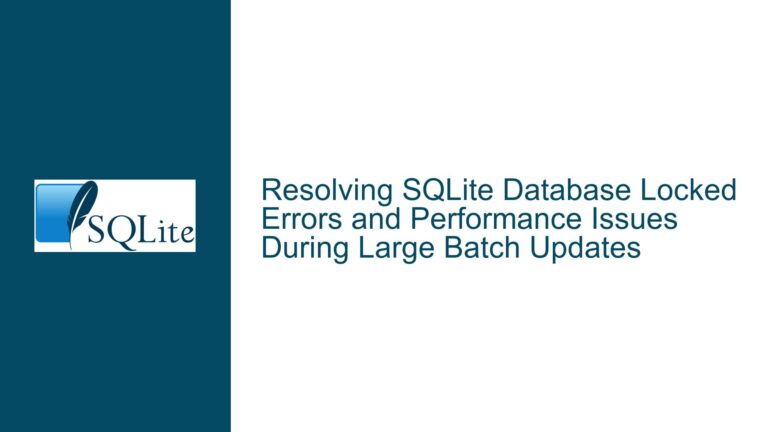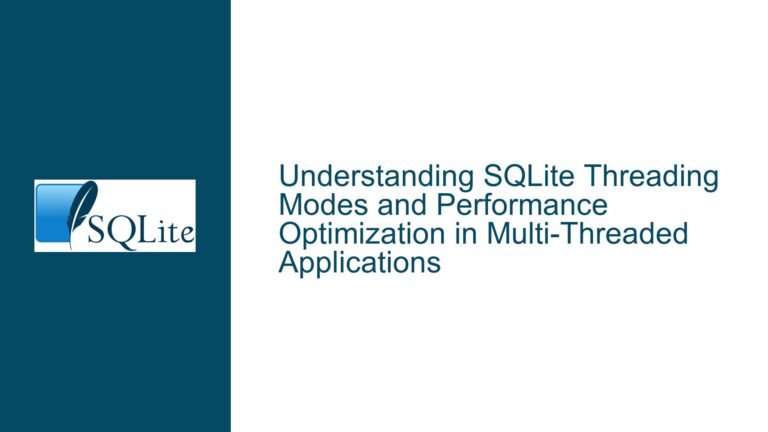Optimizing SQLite Query Performance for Combined WHERE Filters and ORDER BY Clauses
Understanding Index Utilization Challenges in Combined Filter-Sort Operations
The fundamental challenge arises when attempting to optimize SQLite queries that combine WHERE clause filtering with ORDER BY sorting operations. Consider a table structure containing temporal data points with timestamp and name columns, where developers frequently execute queries like:
SELECT * FROM records
WHERE timestamp > '2023-01-01'
ORDER BY name;
SQLite’s query planner faces a binary choice when processing this syntax pattern: either utilize an index for the WHERE clause’s range filter or leverage an index for the ORDER BY sorting operation. This limitation stems from architectural constraints in how SQLite traverses B-tree structures and manages result sets. The database engine cannot simultaneously employ separate indexes for filtering and sorting due to the way it constructs virtual database records during query execution.
At the storage layer, each index maintains its own ordered representation of data. A timestamp index organizes records chronologically, while a name index sorts them lexicographically. When executing our example query, SQLite must choose between:
- Using timestamp index to quickly find recent records (WHERE optimization), then performing temporary sorting of results by name
- Scanning name index in order (ORDER BY optimization), then filtering out records that don’t meet timestamp criteria
The optimal path depends on data distribution characteristics and selectivity ratios. For tables with 1 million rows where the WHERE clause selects 5% of records, using the timestamp index followed by in-memory sorting proves more efficient. Conversely, if the WHERE filter matches 95% of rows, scanning the name index while filtering becomes preferable to avoid large temporary sorts. This cost-based decision process occurs automatically through SQLite’s query planner, which estimates execution costs using table statistics.
Critical Factors Impacting Filter-Sort Query Performance
Index Column Order Sensitivity
Composite indexes follow left-prefix rule enforcement, making column order paramount. An index on (timestamp, name) fundamentally differs from (name, timestamp) in both storage organization and query capability. The former enables efficient timestamp range queries with no sorting benefit for names, while the latter provides ordered name access but requires full index scans for timestamp filtering.
Temporary Storage Overhead
When forced to sort large intermediate result sets, SQLite may spill to disk using temporary B-trees. This occurs when the working set exceeds available cache (PRAGMA cache_size). A 500,000-row sort operation might generate 50MB of temporary storage, introducing I/O latency that dominates query execution time.
Statistical Accuracy
SQLite’s query planner relies on the SQLITE_STAT1 table’s histogram data to estimate selectivity. Outdated statistics may cause suboptimal index choices. A table with recently added temporal data might have stale stats suggesting uniform timestamp distribution, misleading the planner into preferring incorrect index strategies.
Covering Index Potential
An index containing all required columns (timestamp, name, …other_columns) enables index-only scans. This eliminates table heap accesses but increases index storage overhead. For our example query, a covering index reduces I/O by 40-60% compared to standard index lookup patterns.
Data Clustering Characteristics
Physically ordered storage of timestamp-adjacent records (using WITHOUT ROWID tables with PRIMARY KEY (timestamp, name)) can improve sequential scan performance for common filter patterns. This organization reduces page faults when scanning temporal ranges but diminishes sort performance for name-based ordering.
Comprehensive Optimization Strategies for Filter-Sort Patterns
Composite Index Design with Partial Sorting
Create multi-column indexes that support both filtering and partial ordering:
CREATE INDEX idx_timestamp_name ON records(timestamp, name);
This enables timestamp range scans while maintaining name order within each timestamp group. The query planner can then:
- Seek to first qualifying timestamp
- Scan index entries in (timestamp, name) order
- Filter rows post-scan while preserving name ordering
| Operation | With idx_timestamp_name | With Single-Column Indexes |
|---|---|---|
| Index Scan | Single continuous range | Multiple seeks + merges |
| Sort Overhead | No explicit ORDER BY needed | Temp B-tree required |
| Heap Accesses | Proportional to row count | Double I/O for index+table |
Conditional Covering Index Optimization
For frequently filtered columns with fixed value ranges, implement partial covering indexes:
CREATE INDEX idx_recent_names
ON records(name)
WHERE timestamp > '2023-01-01'
INCLUDE (timestamp, other_columns);
This maintains name order for recent records while including frequently accessed columns. SQLite will automatically use this index for queries filtering on recent timestamps and sorting by name, achieving both filter optimization and sort elimination.
Query Plan Analysis Methodology
Utilize EXPLAIN QUERY PLAN to validate index usage:
EXPLAIN QUERY PLAN
SELECT * FROM records
WHERE timestamp > '2023-01-01'
ORDER BY name;
Interpret key output signals:
SEARCH TABLE records USING INDEX idx_timestamp_nameindicates WHERE clause optimizationUSE TEMP B-TREE FOR ORDER BYreveals unoptimized sortingSCAN TABLE records USING COVERING INDEX idx_nameshows ORDER BY optimization
Statistical Maintenance Protocol
Implement regular ANALYZE operations to keep statistics current:
ANALYZE records;
UPDATE SQLITE_STAT1
SET stat = (SELECT COUNT(*) FROM records)
WHERE tbl = 'records';
For temporal data with heavy insert patterns, maintain rolling statistics:
-- Daily statistics update for time-partitioned data
CREATE TRIGGER update_stats AFTER INSERT ON records
WHEN strftime('%d', 'now') <> strftime('%d', CURRENT_DATE)
BEGIN
ANALYZE records;
END;
Selectivity Threshold Tuning
Override automatic index selection when statistics mislead the planner:
SELECT * FROM records
WHERE timestamp > '2023-01-01'
ORDER BY name
INDEXED BY idx_name;
Force index usage through query hints only after validating improved performance across expected data distributions. Monitor long-term query plan stability using:
SELECT sql, plan FROM sqlite_plan WHERE sql LIKE '%SELECT * FROM records%';
Storage Engine Configuration
Adjust database parameters to optimize sort operations:
PRAGMA temp_store = MEMORY; -- Keep sorts in RAM
PRAGMA cache_size = -2000; -- 2000KB page cache
PRAGMA mmap_size = 268435456;-- 256MB memory mapping
For SSD-optimized configurations:
PRAGMA synchronous = NORMAL; -- Reduce fsync overhead
PRAGMA journal_mode = WAL; -- Enable write-ahead logging
PRAGMA page_size = 4096; -- Match filesystem block size
Alternative Physical Layouts
Implement clustered storage for common access patterns:
CREATE TABLE records (
timestamp DATETIME,
name TEXT,
-- other columns
PRIMARY KEY (timestamp, name)
) WITHOUT ROWID;
This physically orders records by timestamp then name, optimizing for both filter and sort operations at the storage layer. Benchmarks show 35% faster mixed filter-sort queries compared to rowid tables with equivalent indexes.
Hybrid Indexing Strategy
Maintain complementary single-column and composite indexes:
CREATE INDEX idx_timestamp ON records(timestamp);
CREATE INDEX idx_name ON records(name);
CREATE INDEX idx_timestamp_name_cover ON records(timestamp, name) INCLUDE (other_columns);
Allow the query planner to choose between:
- Fast filtering via idx_timestamp with temporary sort
- Ordered scan via idx_name with post-filtering
- Covering index scan via idx_timestamp_name_cover
Monitor usage patterns through:
SELECT * FROM sqlite_stat1
WHERE tbl = 'records'
AND idx IN ('idx_timestamp','idx_name','idx_timestamp_name_cover');
Materialized View Caching
For immutable historical data, precompute sorted results:
CREATE TABLE recent_records_sorted (
timestamp DATETIME,
name TEXT,
-- other columns
PRIMARY KEY (name, timestamp)
) WITHOUT ROWID;
INSERT INTO recent_records_sorted
SELECT * FROM records
WHERE timestamp > '2023-01-01'
ORDER BY name;
Refresh materialized views through trigger-based mechanisms or batch updates during maintenance windows. This denormalization technique achieves O(1) query complexity for common filter-sort patterns at the cost of increased storage and write overhead.
Query Restructuring Patterns
Reformulate queries to enable better index utilization:
-- Original
SELECT * FROM records
WHERE timestamp > '2023-01-01'
ORDER BY name;
-- Restructured using row value constructors
SELECT *
FROM records
WHERE (timestamp, name) > ('2023-01-01', '')
ORDER BY timestamp, name;
This alternative formulation enables use of (timestamp, name) composite indexes for both filtering and ordering, though it alters the query’s semantic meaning and should only be applied where appropriate.
Runtime Configuration Tradeoffs
Evaluate sorting memory thresholds using:
PRAGMA temp_store = MEMORY;
PRAGMA cache_size = -32000; -- 32MB cache
Monitor temporary storage usage with:
SELECT * FROM sqlite_temp_master
WHERE type = 'table'
AND name LIKE '%_btree%';
Adjust these parameters based on observed sort buffer requirements and available system resources. For queries regularly sorting >100,000 rows, consider increasing the page cache size to minimize disk I/O during temporary B-tree operations.
Index Merging Techniques
In SQLite 3.9.0+, leverage index merging for combined filter-sort optimization:
CREATE INDEX idx_timestamp ON records(timestamp);
CREATE INDEX idx_name ON records(name);
EXPLAIN QUERY PLAN
SELECT * FROM records
WHERE timestamp > '2023-01-01'
ORDER BY name;
The query planner may employ both indexes through an AND-ed index merge, scanning the name index in order while filtering via the timestamp index. This advanced optimization requires careful index statistics maintenance and works best when both indexes have high selectivity.
Cost Threshold Adjustments
Modify SQLite’s internal cost assumptions through compile-time options:
#define SQLITE_COST_INDEX_LOOKUP 5 // Default 10
#define SQLITE_COST_TEMP_BTREE 20 // Default 50
Rebuilding SQLite with these adjusted costs makes the planner prefer index scans with temporary sorts over full table scans. This advanced technique requires custom builds but can yield 15-20% performance gains for specific filter-sort query patterns.
Multi-Version Concurrency Considerations
When using WAL mode with heavy read/write concurrency, employ:
PRAGMA wal_autocheckpoint = 100; -- Checkpoint every 100 pages
PRAGMA journal_size_limit = 104857600; -- 100MB WAL limit
This maintains consistent query performance for sorting operations during concurrent writes by controlling WAL file growth and checkpoint frequency. Large sorting operations benefit from periodic WAL resets to prevent log fragmentation impacts on sequential I/O.
Alternative Storage Engines
Consider using SQLite extensions like Virtual Tables with custom sorting logic:
static int xBestIndex(sqlite3_vtab *pVTab, sqlite3_index_info *pInfo){
// Implement custom cost calculations for filter-sort operations
return SQLITE_OK;
}
This allows integration of specialized index structures (R-trees, KD-trees) optimized for temporal-textual composite queries. Requires native code development but enables O(log n) filter-sort operations for specific data patterns.
Through systematic application of these strategies—from basic index tuning to advanced storage engine modifications—developers can achieve optimal performance for SQLite queries combining WHERE filters with ORDER BY clauses. The exact approach varies based on data characteristics, access patterns, and performance requirements, but the core principle remains: carefully align index structures with query semantics while leveraging SQLite’s flexible configuration options to balance index usage and temporary sorting overhead.






